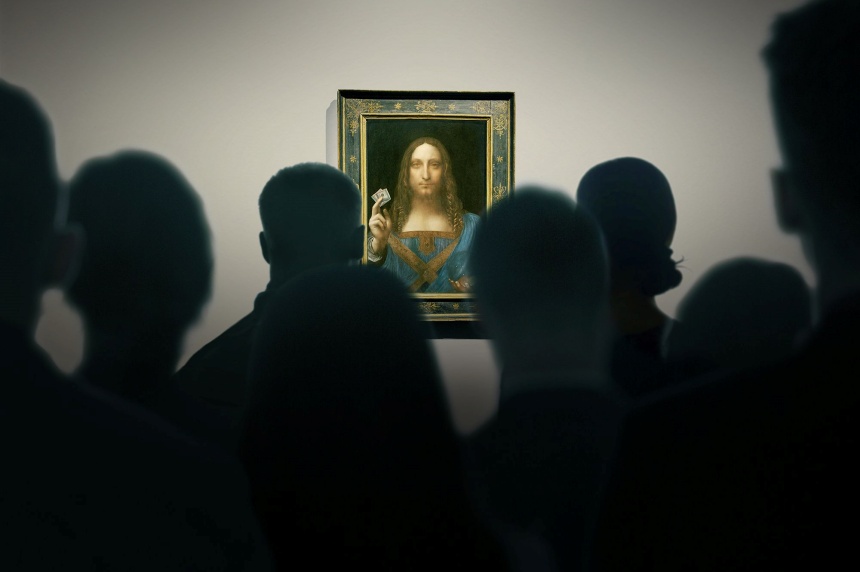The Lost Leonardo
⭐ ⭐ ⭐ ⭐
Run Time: 1 hour 30 minutes
Director: Andreas Koefoed
In Theaters
Reviewed at the Tribeca Film Festival; opens in theaters August 13
The Salvator Mundi is a very pretty picture. Few people argue that point. Dating to the early 16th century, the painting of Jesus Christ as “Savior of the World” — the work’s translated title — has an ethereal, almost spooky quality.
Legend has it that the original version — painted by none other than Leonardo da Vinci — was lost centuries ago, and since then it has been known only through copies made by Leonardo’s students and successors.
But that’s where director Andreas Koefoed picks up the story in this dazzlingly complex documentary that plunges head-first into the dizzying world of art history, art restoration, and most importantly, art marketing.
Koefoed introduces us to Alexander Parrish and Robert Simon, a pair of avuncular New York art dealers who stumble upon a curious “copy” of the Salvator Mundi in a low-rent New Orleans auction house. They buy it on a whim, thinking at worst it’s a second generation copy and at best it was painted by an actual student of Leonardo.
But this Salvator Mundi is in absolutely awful shape — riddled with gouges and layers of amateurish repairs. The thing is not only unsellable, it’s downright difficult to even look at. So they hire one of the world’s most celebrated art restorers, a mild-mannered painter named Dianne Modestini, to fill in the gouges, remove the terrible touch-ups and, generally, try to make Salvator Mundi look good as new.
Modestini does manage to turn Salvator Mundi into something of a masterpiece, but along the way she makes a startling discovery: In one of the few untouched square inches of the painting, the artistry points inevitably to the hand of the Master himself.
In that one moment of supposed revelation, the value of Salvator Mundi goes from a few tens of thousands of dollars to, literally, untold hundreds of millions.
And all that happens in the first 15 minutes or so of the movie.
What follows is a head-spinning yarn of international financial intrigue populated by self-important art experts, steely-eyed Russian oligarchs, and haughty auction house owners whose only vested interest in the authenticity of the painting lies in how much they can get for it.
Quite a bit, as it turns out. In a pulse-pounding scene filmed at Christie’s auction house in New York City, faceless bidders represented by poker-faced people wielding cell phones push the price tag ever higher; blowing past every previous sales record and finally landing at more than $450 million.
The buyer: unknown.
Eventually, the painting itself disappears in the turgid seas of global art commerce. Indeed, according to Koefoed, Salvator Mundi may have become a form of international currency, changing hands multiple times as part of far-flung business deals struck by tycoons who have zero interest in Salvator Mundi as art, but a whole lot as a tradable commodity.
One thing is for sure: Salvator Mundi has not hung on a museum wall for the better part of a decade.
For the film’s pièce de résistance, we end up in the deserts of Saudi Arabia, where Crown Prince Mohammed bin Salman — yes, the very same guy who masterminded the assassination of Washington Post writer Jamal Khashoggi — may or may not be planning to exhibit the painting in a new cultural arts center. For the moment, insiders say, the painting is languishing on the prince’s yacht — which can only conjure up images of Marlon Brando hanging the stolen Mona Lisa over his Long Island fireplace in 1990’s The Freshman.
In a world where people who call themselves art lovers pay millions for digital “non-fungible tokens,” it’s almost quaint to see the uber-privileged class tripping all over themselves to own a painting that, while it just might be five percent from the brush of an Old Master, is most certainly 95 percent the creation of a 21st century woman, sitting at an easel in her Manhattan loft.
Featured image: The Lost Leonardo (Sony Pictures Classics)
Become a Saturday Evening Post member and enjoy unlimited access. Subscribe now



